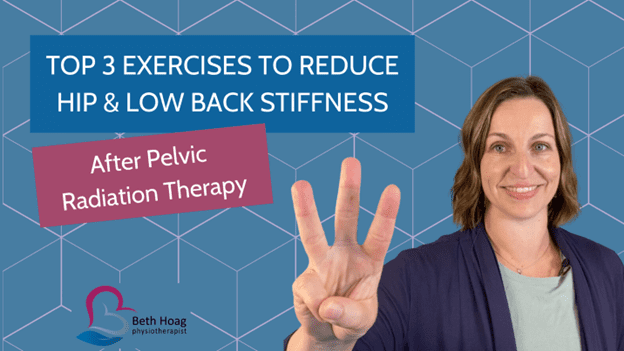Here's the Reality
We know that MANY women experience pelvic health problems after treatment for breast cancer. Specifically, 50 – 75% of survivors experience 1 or more pelvic health issues after their treatment (Ganz et al 1998, Trinkaus et al 2008). We also know that 50-60% of BC survivors experience problems with sexuality resulting from treatment (Den et al 2019).
Unfortunately, we also know that these numbers are likely an underestimate because women are hesitant to report their pelvic health concerns to their medical team and clinicians rarely ask these questions (in part because they are unsure how to address these problems.)
So how do you know how to be proactive, what to watch out for and where to get help?
Read on my friend…. You’ve come to the right place!

The Role of Estrogen in Pelvic Health
The female genitals (i.e. vulva and vagina) are rich with estrogen receptors; they rely on estrogen to keep the tissues thick, pliable, lubricated and generally healthy. After menopause, there is a significant impact on a woman’s pelvic health due to the loss of estrogen “feeding” these tissues.
Typically, this reduction in circulating estrogen happens slowly and gradually over a 10-or-so-year period (i.e. peri-menopause). Our bodies have a chance to adapt slowly to these changes making the transition less abrupt. Unfortunately, this is not the case for women who have been put into menopause through surgery or medication.
Menopause and Breast Cancer
One of the most common reasons for pelvic health problems after treatment is related to the hormonal changes associated with menopause. For women whose cancer was estrogen-driven, part of the goal to reduce recurrence risk will be to reduce circulating estrogen in the body. In other words, the goal is to induce menopause, regardless of a woman’s age.
For women who were pre-menopausal at the time of diagnosis, menopause may be induced either surgically (i.e. removal of the ovaries) or chemically (i.e. using medications to stop the ovaries from producing estrogen). I call this “menopause at the flick of a switch.”
For women who were already post-menopausal at the time of their cancer diagnosis, many will be prescribed a medication called an Aromatase Inhibitor (e.g. Femara, Arimidex, Aromasin) to stop estrogen production even further (note: estrogen is also produced in a woman’s fat cells).
Genitourinary Syndrome of Menopause
Genitourinary Syndrome of Menopause (GSM) is the term we now use to describe the range of changes that can occur in a woman’s pelvic region after menopause. It acknowledges the implications of menopause to the vulva (outer genitalia), vagina (inner canal) and urinary tract.
The symptoms of GMS include the following:
Vulva / Vagina
Dryness, burning, itching, irritation, chafing, tissue thinning, vaginal narrowing/stenosis
Urinary Symptoms
Urgency pain with urination recurrent urinary tract infections (UTIs) bladder leakage
Sexual Dysfunction
Pain, lack of lubrication |
Though any woman is at risk of experiencing GSM symptoms after menopause, women who are taking an Aromatase Inhibitor as a part of their treatment plan are at nearly TWICE the risk of developing GSM symptoms as compared to the regular population (Chollet at al. 2011).

What YOU can do to Maximize your Pelvic Health After Breast Cancer
Here are a few tips to maximize your pelvic health:
- Moisturize daily
- Just like our skin appreciates a regular moisturizer, so does the vulva and vagina (especially after menopause). Try using a vulvovaginal moisturizer made with hyaluronic anywhere from twice a week to daily. This can add valuable moisture to the tissues and make you more comfortable. Some of the ones I recommend include RepaGyn, Yes VM, Mae and Cleo (by Damiva) and Menopause Chicks.
- Use water only for cleaning
- Think of your vulva and vagina like a “self-cleaning oven.” You don’t need to add harsh soaps to this area as it can really dry the tissues out. Stick to rinsing with water and let your vulva and vagina do the rest!
- Throw away the douches and “feminine hygiene sprays”
- If you own these… please, please, please throw them out! Remember the “self-cleaning oven” comment above? Yep… there is absolutely ZERO need to use these harsh products that do nothing more than introduce irritating (and possibly dangerous) chemicals to a very sensitive area of your body.
- Lube, lube and more lube
- Vaginal lubricants are your friend during sexual activity. They reduce friction to your sensitive tissues and can make sex more enjoyable. Please note, however, that not all lubricants are created equally. Many of the commonly available lubricants in your local drugstore should NOT be used (due to certain chemicals, inappropriate pH and osmolality levels). A couple lubricants that I often recommend are YESWB , Blossom Organics Natural, Desert Harvest Aloe Glide and Good Clean Love.
- Stop smoking
- Cigarette smoking is associated with a three-fold increase in the risk of urinary urgency (needing to pee) and frequency (peeing more often) and speeds up the rate of vulvovaginal atrophy (thinning of the tissues).
- (Tahtinen et al. 2011) and (Karamanidis et al. 2001)
And Finally….
See a pelvic health physiotherapist…
If you are experiencing pelvic health problems after cancer, please know that you are NOT ALONE! If the above tips are not giving you enough relief, or you would prefer to speak with someone about your unique situation, please do not hesitate to reach out to a pelvic health physiotherapist (ideally someone who also has knowledge about breast cancer rehabilitation) today.
You deserve to live well, in ALL aspects of life, after your breast cancer diagnosis and treatment.
Have questions about Pelvic Health?
References
- Chollet JA. (2011) Update on alternative therapies for vulvovaginal atrophy. Patient Prefer Adherence. 5: 533-6.
- Den Ouden MEM, Pelgrum-Keurhorst MN, Uitdehaag MJ, De Vocht HM (2019) Intimacy and sexuality in women with breast cancer: professional guidance needed. Breast Cancer. May;26(3):326-332
- Ganz, P., Rowland, J., Desmond, K., Meyerowitz, B., and Wyatt, G. (1998) Life after breast cancer: understanding women’s health-related quality of life and sexual functioning. J Clin Oncol 16: 501-514.
- Karamanidis, D., Tamiolakis, D., Koutsougeras, G., Tripsanas, C., Retzos, K., Karidis, S. et al. (2001) Cigarette smoking and the degree of maturation of the vaginal squamous epithelium in postmenopausal women. Clin Exp Obstet Gynecol 28: 274–276.
- Tahtinen, R., Auvinen, A., Cartwright, R., Johnson, T., Tammela, T. and Tikkinen, K. (2011) Smoking and bladder symptoms in women. Obstet Gynecol 118: 643–648.
- Trinkaus, M., Chin, S., Wolfman, W., Simmons, C. and Clemons, M. (2008) Should urogenital atrophy in breast cancer survivors be treated with topical estrogens? Oncologist 13: 222-231.
Disclaimer – These blogs are for general information purposes only. Medical information changes daily, so information contained within these blogs may become outdated over time. In addition, please be aware that the information contained in these blogs is not intended as a substitute for medical advice or treatment and you should always consult a licensed health care professional for advice specific to your treatment or condition. Any reliance you place on this information is therefore strictly at your own risk.





